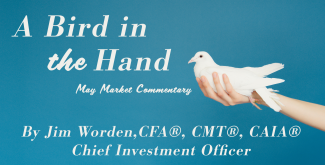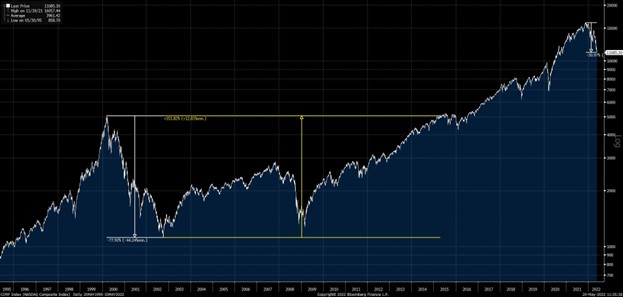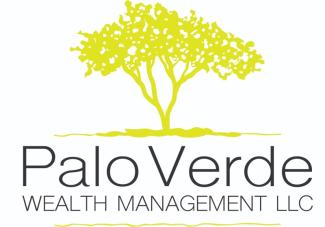
A Bird in the Hand: May Market Commentary
We recently set up a wild bird feeder in our backyard – hoping to attract all kinds of wild birds. Our dogs, Chris and Miss (we got them before Christmas 7 years ago) seem to confuse the movements of the birds and those of squirrels. When we first put up the bird feeder, we attracted more squirrels than birds. But the design, pole, and location of the bird feeder makes it squirrel-proof, much to the chagrin of the squirrels. Now, all kinds of birds are enjoying the feeder. This got me thinking of an old investment adage I heard years ago – a bird in the hand is worth two in the bush.
From an investment perspective, it was explained to me that strong established companies that are paying attractive dividends today are often better positioned than newer companies that were growing, but perhaps not paying any dividends until several years later. This was excellent context for me as I started my career in the late 90s. The internet was new, and for a time, all that seemed necessary for a

company to have was a business plan and a website and they could go public. Back then, it didn’t really seem to matter whether the companies had growing revenue, were cash flow positive, or had sustainable earnings. Subsequently, the Nasdaq Composite, home to many of these technology companies at the time, dropped by roughly 80% in price from early 2000 to late 2002 and the economy eventually went into a recession. It took roughly 12 years for the Nasdaq to get back to those March of 2000 levels (see chart below).
Source: Bloomberg
Fast forward to today and we find ourselves on the verge of a bear market for the S&P 500 and potentially another recession. This time around, it seemed all about software as a serve (SaaS), interactive fitness, new telecommuting technologies, and some fascinating work on newer technologies – artificial intelligence/machine learning, self-driving cars, DNA editing, vertical take off and landing (VTOL) taxi services, a metaverse/omniverse with virtual/augmented reality, decentralized finance, and personalized medicine.
Don’t get me wrong – a lot of these actually sound extremely interesting and I’m sure several will be very promising for society. But should one pay a price of 700 times current earnings to be a shareholder? For some companies, earnings may not even be positive for several years. But coming out of the pandemic and with massive amounts of liquidity and interest rates near zero, the cost of money felt less relevant so long as everything was growing. Certainly, the fear of inflation and future higher costs of capital wasn’t on anyone’s radar at the time.
Now, companies are dealing with cautious consumers, higher energy and food prices, higher wage costs, and much higher borrowing costs than they have been used to. Another axiom I heard many years ago is “the rule of 20.” The rule of 20 suggests that the markets are fairly valued when the Price/Earnings (P/E) ratio added to the inflation rate equals 20. For years this rule of thumb seemed to just focus on the P/E ratio, since inflation for so long seemed to be only around 2% or lower. Now that inflation is at 8.3% and no one knowing for certain when it will significantly drop, valuations have mattered more.
Not only do valuations matter, but a company’s competitive advantage, or moat matters more. Companies that have the advantage to pass-through some inflation will have stronger profit margins than those that cannot. The quality of earnings and how a company uses debt matters more. This is especially true for companies focused on growth and not planning on paying any dividends soon. Just as a surge in mortgage rates impacts housing affordability, a surging cost of capital makes it that much more difficult to assign a higher valuation to high growth companies using discounted cash flow analysis.
So long as inflation stays high, valuations and quality will continue to matter more than growth. We see there being three types of companies in the current environment: a) companies that are still overvalued and need to come down more in price; b) companies that never got overvalued and are producing strong cash flows, earnings, and are often paying attractive dividends; and c) companies that were excessively valued, continue to have strong growth potential, and now are attractively priced.
We are constantly looking at how can we position portfolios to the extent possible to avoid or minimize the exposure to companies in the first group and invest in companies in the latter two groups. We believe this current downturn will likely be short-lived and not anything like the early 2000s period. Just as we got through those other difficult periods, we will get through this difficult period as well. The markets tend to educate and humble the best of us and remind us that often “a bird in the hand is worth two in the bush.”

Jim Worden offers investment advice through WCG Wealth Advisors, LLC, a Registered Investment Advisor doing business as The Wealth Consulting Group. Jim is not affiliated with LPL Financial.
The opinions expressed are only general information and not intended to provide specific advice or recommendations for any individual.
All performance referenced is historical and is no guarantee for future results. All indices are unmanaged and may not be invested into directly.

